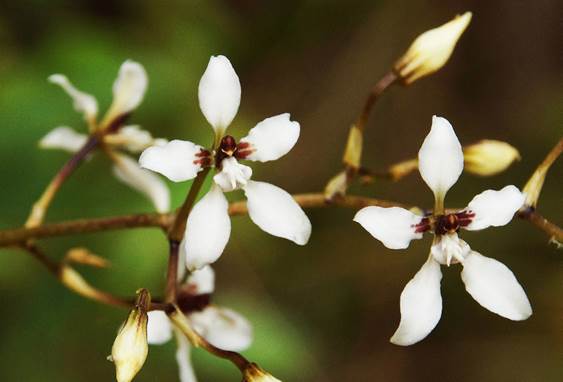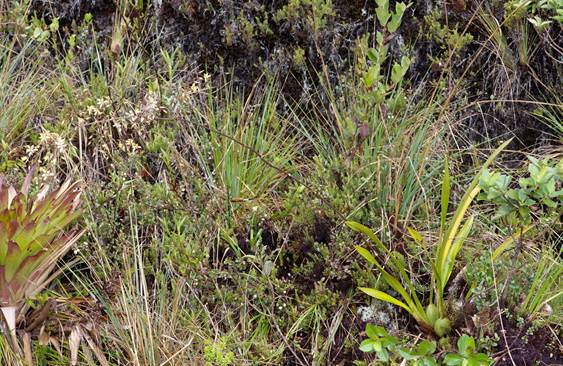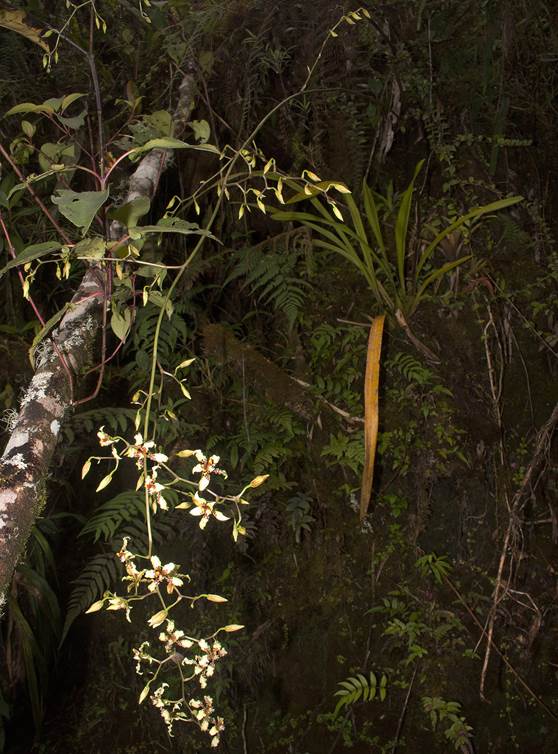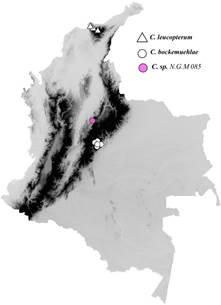Introduction
The orchid that is described here was first brought to scientific attention by Leonore Bock- emühl in her monographic treatment of Odontoglos- sum Kunth (Bockemühl 1989). It was incorrectly featured as ''Odontoglossum leucopterum Rchb.f.'', in subgenus Unguisepala Bockemüh. The real ''Odm. leucopterum'' is a species from the Sierra Nevada de Santa Marta in northern Colombia and which may appear superficially similar to the new species but differs distinctly in certain morphological features and general appearance (Fig. 1). ''Odontoglossum leucopterum'' was transferred to Cyrtochilum leucopterum (Rchb.f.) Dalström (Dalström 2001). Preserved specimens have been examined; the holotype at the Museum of Natural History in Vienna (Funck & Schlim 989, W), which corresponds to a collec- tion in the Herbarium of the Royal Botanical Garden at Kew (J. Hanbury-Tracy 493, K; Fig. 2). Very re- cently, however, some authentic color photographs of C. leucopterum were taken by Arthur Evans along the road from ProAves ecolodge, El Dorado, towards the San Lorenzo Ridge on Sierra Nevada de Santa Marta (Fig. 3-4). When Bockemühl’s ''leucopterum'' (Bockemühl 1989) is compared with the type specimen as well as the live flowers of C. leucopterum, it becomes clear that they represent different species.
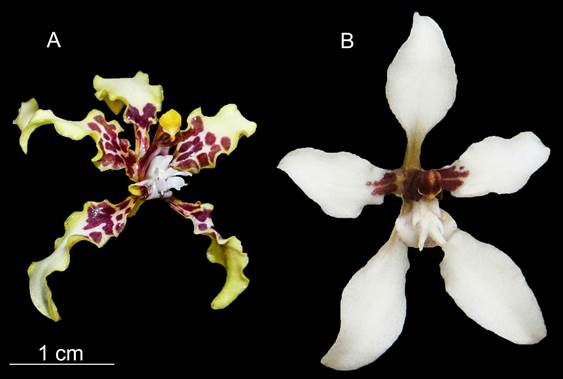
A. Cyrtochilum bockemuehlae.
B. Cyrtochilum leucopterum.
Figure 1. Photos by Cristian Castro (A) and Arthur Evans (B).

A. Flower, lateral view.
B. Lip and column, lateral view.
C. Column, ventral view.
D. Anther cap, dorsal and ventral views.
E. Lip, lateral view.
F. Lip, ventral view.
G. Flower dissected.
Illustration from J. Hanbury-Tracy 493 (K) by Stig Dalström.
Figure 2 Line drawing of Cyrtochilum leucopterum (Rchb.f.) Dalström.
The new species may not have been observed in the past because no older collections have been located in the main herbaria, or it has been misidentified by earlier collectors. Only recently were plants observed and properly identified at higher elevation cloud forest environments, primarily in the Colombian Departments of Cundinamarca and Meta (Fig. 5-6). Most recently, plants have also been seen in private collections in Bogota. Plants of this rather large and bulky species tend to grow terrestrially among dense shrubs and often along roadsides where sufficient light and air circulation are provided. The natural variation and geographic distribution of the new species is not very well understood due to a lack of sufficient material to study. The general morphology of the flower tends to be rather consistent, however, although there appears to be some variation in the in- tensity and patterns of the colors.
Taxonomic Treatment
Cyrtochilum bockemuehlae C.Castro, J.S.Moreno & Dalström, sp. nov. (Fig. 7-8).
TYPE: Colombia. Cundinamarca: Municipio de Fómeque; 40-70 km la Calera hacia Golillas en la entrada a la Reserva de Carpanta 4° 33’32.9'' N; 73° 43’11.5'' W, 3212 m, 28 Nov. 2018, C. Castro et al. 1670 (holotype: COL).
Diagnosis: Cyrtochilum bockemuehlae is visually distinguished from the closely related C. dipterum (Lindl.) Dalström, C. ionoplocon (Rchb.f.) Dalström, C. leucopterum, C. ramosissimum (Lindl.) Dalström, and C. sodiroi (Schltr.) Dalström, by having strik- ingly different coloration of the flowers in combination with morphological differences, primarily in the lip-column structure, as can be seen in the included illustrations (Fig. 9-10).
Terrestrial or epiphytic herb. Plant robust and large for the genus. Pseudobulbs caespitose, ovoid, to ca. 10 × 5 cm, bifoliate, surrounded basally by up to 8 foliaceous sheaths. Leaf conduplicate, linear, narrowly acute to acuminate, ca. 110 × 4-5 cm. Inflorescence 1 or 2, axillary from the base of the pseudobulb and the uppermost sheaths in an emerging new growth, suberect to arching, or subpendent, rather straight with widely spaced and spreading multifloral, indistinctly flexuous or fractiflex to ca. 40 cm long side-branches, incomplete in the featured illustration but exceeding 170 cm in the type specimen. Peduncular and Floral bracts waxy, appressed, scale-like, acute, 4-24 mm long. Pedicel with ovary 17-24 mm long. Flowers spidery with recurved white to pale yellow sepals and petals, more or less spotted with purple to brown; lip pale yellow and purple with a white callus; dorsal sepal unguiculate, elliptic, obtuse, more or less un dulate and recurved, 15-20 × 5-7 mm; lateral sepals unguiculate, slightly oblique, elliptic, obtuse to acute, more or less undulate and recurved, 15-21 × 4-5 mm; petals subsessile, ovate to elliptic, acute, more or less undulate and recurved, 13-18 × 5-7 mm; lip rigidly attached to the base of the column through a short, central, longitudinal, fleshy keel, trilobed with spreading, revolute unevenly deltoid to auriculate lateral lobes and a strongly reflexed, elongated triangular, ligulate, apically acuminate front-lobe, 12-14 × 5-7 mm; callus of a pair of fleshy, longitudinal erect and apically sub-falcate ridges emerging gradually from the base of the lip and extending to the base of the front-lobe, with a pair of narrowly digitate denticles on each side near the end, and a fleshy, narrowly denticulate pair of keels in between, and with a fleshy apical denticle in the middle; column pale brown to purple, straight, clavate, ventrally furrowed, to 7-9 mm long excluding the anther cap; anther cap white to dark yellow, campanulate, indistinctly rostrate and dorsally lobulate, 1.9 × 2.7 mm; pollinarium of two folded/cleft pyriform pollinia on a linear, ca. 1.3 mm long stipe, on an ovoid pulvinate viscidium.
Paratypes: Colombia. Cundinamarca: Municipio de Fómeque; 40-70 km la Calera hacia Golillas entrada a la Reserva Carpanta, 4° 42’18.11''-4° 33’51.5'' N; 73° 44’19''-73° 48’13.5'' W, alt. 3450-3690 m, 10 Dic. 2016, C. Castro et al. 699 (COL). Municipio Junín, vereda Colombia, Sector Carpanta, 2500-2600 m, 6 Ago. 2017, D. E. Hernández-Rodríguez 26 (COL). Municipio de Junín, vereda Colombia, Sector Carpanta, 2400-2500 m, 31 Ene. 2018, D. E. Hernández-Rodríguez 38 (COL). Municipio Gachalá, vereda Tendidos del río Negro, Sector Caño Negro, 2514 m, 23 Ago. 2019, D. E. Hernández-Rodríguez 204 (COL). Municipio Gachalá, vereda Tendidos del río Negro, Sector Alto de Siberia, 2570 m, 24 Ago. 2019, D. E. Hernández-Rodríguez 232 (COL). Meta: Parque Natural Nacional Chin- gaza, la vía hacia San Juanito, al costado izquierdo de la vía asociado a vegetación ruderal, 4°28’ N; 73°41.2’ W, alt. 2870-2900 m, C. Castro et al. 278 (COL).
Distribution
Cyrtochilum bockemuehlae is only documented from along the eastern cordillera in the Departments of Cundinamarca and Meta at altitudes ranging from 2400-3690 m (Fig. 12).
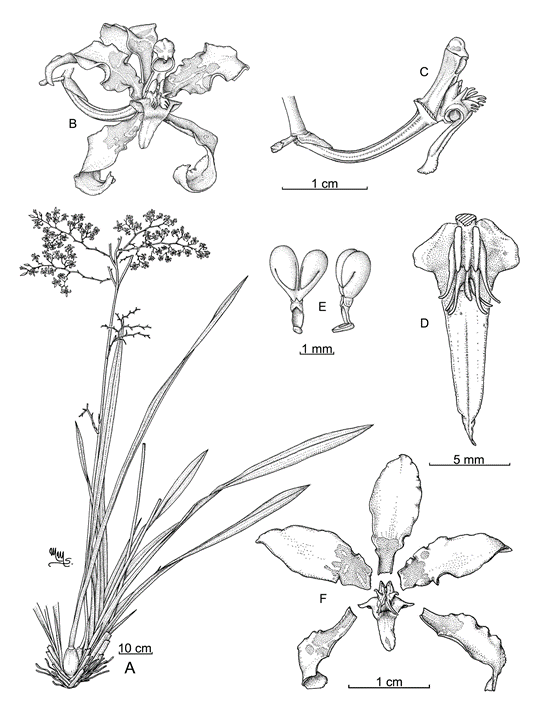
A. Plant habit.
B. Flower, front view.
C. Column and lip, lateral view.
D. Lip, dorsal view.
E. Pollinarium, back and lateral views.
F. Flowerdissected.
Drawn from the holotype by Marcela Morales-Sanchez.
Figure 7 Cyrtochilum bockemuehlae C.Castro, S.Moreno & Dalström.
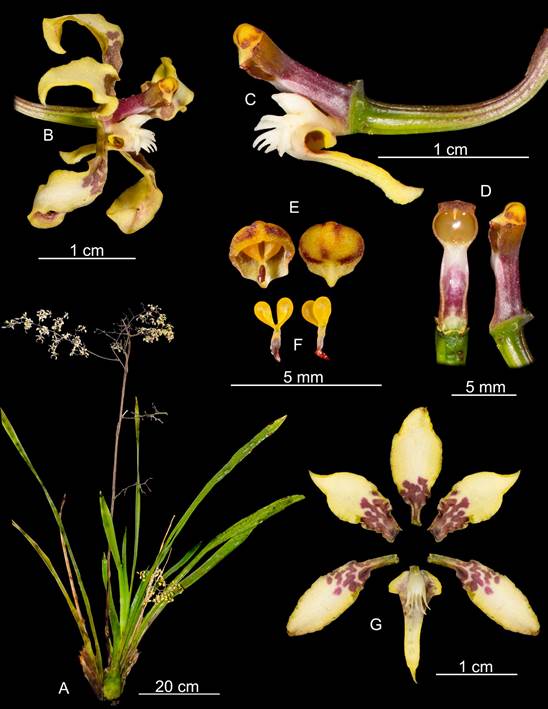
A. Plant habit.
B. Flower lateral view.
C. Column and lip lateral view.
D. Column ventral and lateral views.
E. Anther cap with pollinarium ventral and dorsal views.
F. Pollinarium back and lateral views.
G. Flower dissected.
Photo by Cristian Castro, and arrangement by the authors.
Figure 8 Cyrtochilum bockemuehlae C.Castro, S.Moreno & Dalström.
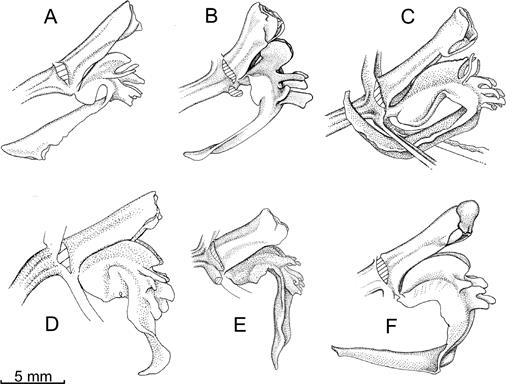
A. C. bockemuehlae (G. De- burghgraeve 020).
B. C. dipterum (F. C. Lehmann 6003).
C. C. ramosissimum (Funk & Schlim 1041).
D. C. amphi- glottis (B. Rözl s.n.).
E. C. leucopterum (J. Hanbury-Tracy 493).
F. C. sodiroi (S. Dalström 606).
All figures drawn by Stig Dalström.
Figure 9 Lip-column comparisons for Cyrtochilum bockemuehlae and related species.
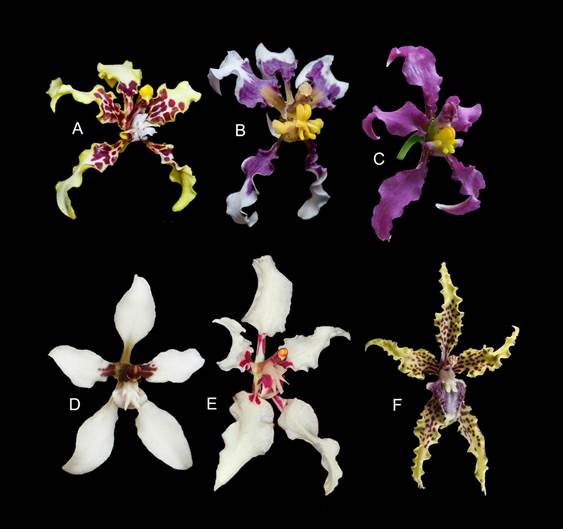
A. C. bockemuehlae (C. Castro 278).
B. C. dipterum.
C. C. ioplocon.
D. C. leucopterum.
E. C. ramosissimum.
F. C. sodiroi.
Photos by Cristian Castro (A), Sebastián Moreno (B, C, F), Arthur Evans (D), and Karlheinz Senghas (E), not in the same scale
Figure 10 Flowers of related Cyrtochilum species.
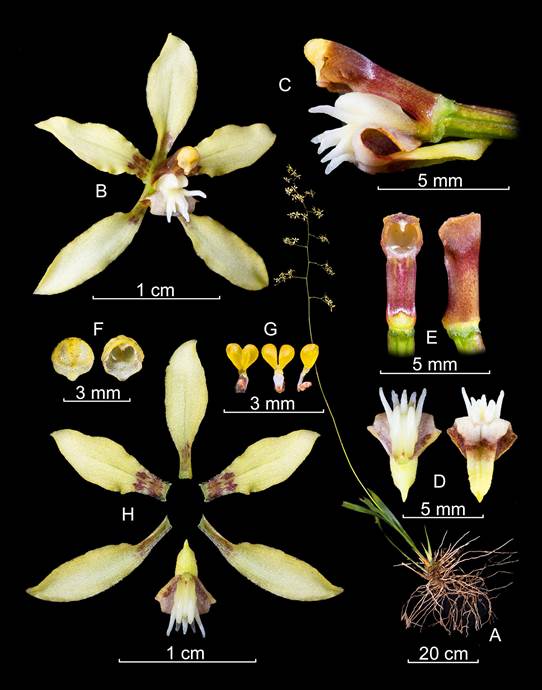
A. Plant habit.
B. Flower, front view.
C. Lip and column, lateral view.
D. Lip, front and back views.
E. Column, ventral and lateral views.
F. Anther cap, dorsal and ventral views.
G. Pollinarium, back, front and lateral views.
H. Dissected flower.
Photo arrangement by Sebastián Moreno based on N. Gutiérrez Morales NGM 85.
Figure 11 Cyrtochilum sp. from the Department of Santander.
Discussion
The morphological features of Cyrtochilum bockemuehlae are very distinct and it can easily be distinguished from closely related species by com- paring the coloration of the flowers in combination with the lip-column views (Fig. 9-10). There is, how- ever, a similar taxon that occurs in the Department of Santander, and which resembles C. bockemuehlae in many floral details, but also differs in others (Fig. 11). The general structure of the flower is superficially similar, but the size of the flower differs significantly with the Santander taxon being almost half the size of C. bockemuehlae (Table 1; Fig. 8, 11). The Santander tax- on also tends to have flatter sepals and petals with less brown-purple markings placed only at the very base of the segments. But these differences alone may prove too variable to have any specific importance. More significant differences, however, can be seen when the lip-column structures are viewed from the side. In C. bockemuehlae the apex of the column is straight to slightly up-curved, while the apex of the column in the Santander taxon is slightly curved downwards. These differences may seem minor, but should be seen in relation to how far the basal callus structure reaches along the ventral side of the column. In C. bockemuehlae the callus extends to about half the length of the column, while in the Santander taxon, the callus extends to near the apex of the column. There are also differences in the outline of the column, which can be seen in the ventral views in the color plates (Fig. 8, 11). In conclusion, there is not enough data available about the natural variation of the Santander taxon, to fairly determine what exactly the taxonomic status is at this time. Hopefully, additional field research will shed more light on this subject. Meanwhile, the Santander taxon will be kept as unresolved and separate from the taxonomic identity of Cyrtochilum bockemuehlae.
Table 1 Morphological comparisons between the holotype of Cyrtochilum bockemuehlae (C. Castro 1670) and Cyrtochilum
| Measurements (length × width) of flower details (mm) | CC 1670 Locality: Cundinamarca | NGM 85 Locality: Santander |
| Dorsal sepal | 15-19 × 5-7 | 10.0 × 4.5 |
| Lateral sepal | 16.0-21.5 × 4.5-5.0 | 11.0 × 2.8 |
| Petal | 13.5-17.5 × 5.0-7.2 | 7.3 × 3.5 |
| Lip | 12.5-14.2 × 5.5-6.5 | 7.9 × 3.5 |
| Column | 6.9-9.0 | 5.2-5.5 |
| Pedicel + ovary | 17.0-23.5 | 18.3-18.5 |












 uBio
uBio 


